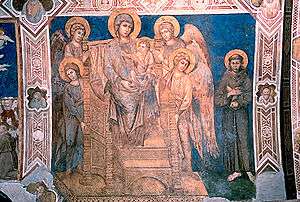Florentine painting
Florentine painting or the Florentine School refers to artists in, from, or influenced by the naturalistic style developed in Florence in the 14th century, largely through the efforts of Giotto di Bondone, and in the 15th century the leading school of Western painting. Some of the best known artists of the Florentine school, including other arts, are Filippo Brunelleschi, Donatello, Michelangelo, Fra Angelico, Botticelli, Lippi, Masolino, and Masaccio.
Before 1400
The earliest distinctive Tuscan art, produced in the 13th century in Pisa and Lucca, formed the basis for later development. Nicola Pisano showed his appreciation of Classical forms as did his son, Giovanni Pisano, who carried the new ideas of Gothic sculpture into the Tuscan vernacular, forming figures of unprecedented naturalism. This was echoed in the work of Pisan painters in the 12th and 13th centuries, notably that of Giunta Pisano, who in turn influenced such greats as Cimabue, and through him Giotto and the early 14th-century Florentine artists.
The oldest extant large scale Floretine pictorial project is the mosaic decoration of the interior of the dome of the Baptistery of St John, which began around 1225. Although Venentian artists were involved in the project, the Tuscan artists created expressive, lively scenes, showing emotional content unlike the prevailing Byzantine tradition. Coppo di Marcovaldo is said to have been responsible for the central figure of Christ and is the earliest Floretine artist involved in the project. Like the panels of the Virgin and Child painted for the Servite churches in Siena and Orvieto, sometimes attributed to Coppo, the Christ figure has a sense of volume.

Similar works were commissioned for the Florentine churches of Santa Maria Novella, Santa Trinita and Ognissanti in the late 13th century and early 14th century. Duccio's panel of around 1285, Madonna with Child enthroned and six Angels or Rucellai Madonna, for the Santa Maria Novella, now in the Ufizi Gallery, shows a development of the naturalistic space and form, and may not have been originally intended as altarpieces. Panels of the Virgin were used at top of rood screens, as at the Basilica of San Francesco d'Assisi, which has the panel in the fresco of the Verification of the Stigmata in the Life of Saint Francis cycle. Cimabue's Madonna of Santa Trinita and Duccio's Rucellai Madonna do, however, retain the earlier stylism of showing light on drapery as a network of lines.

Giotto's sense of light would have been influenced by the frescoes he had seen while working in Rome, and in his narrative wall paintings, particularly those commissioned by the Bardi family, his figures are placed in naturalistic space and possess dimension and dramatic expression. A similar approach to light was used by his contemporaries such as Bernardo Daddi, their attention to naturalism was encouraged by the subjects commissioned for 14th-century Franciscan and Dominican churches, and was to influence Florentine painters in the following centuries. While some were traditional compositions such as those dealing with the order's founder and early saints, others, such as scenes of recent events, people and places, had no precedent, allowing for invention.
The 13th century witnessed an increase in demand for religious panel painting, particularly altarpieces, although the reason for this is obscure, early 14th-century Tuscan painters and woodworkers created altarpieces which were more elaborate, multipanelled pieces with complex framing. Contracts of the time note that clients often had a woodwork shape in mind when commissioning an artist, and discussed the religious figures to be depicted with the artists. The content of the narrative scenes in predella panels however are rarely mentioned in the contracts and may have been left to the artists concerned. Florentine churches commissioned many Sienese artists to create altar pieces, such as Ugolino di Nerio, who was asked to paint a large scale work for the altar for the Basilica di Santa Croce, which may have been the earliest polyptych on a Florentine altar. The guilds, cognizant of the stimulus that external craftmanship brought, made it easy for artists from other areas to work in Florence. Sculptors had their own guild which held minor status, and by 1316 painters were members of the influential Arte dei Medici e Speziali. The guilds themselves became significant patrons of art and from the early 14th century various major guilds oversaw the upkeep and improvement of individual religious buildings; all the guilds were involved in the restoration of Orsanmichele.
The naturalism developed by the early Florentine artists waned during the third quarter of the 14th century, likely as a consequence of the plague. Major commissions, such as the altarpiece for the Strozzi family (dating from around 1354-57) in Santa Maria Novella, were entrusted to Andrea di Cione, whose work, and in that of his brothers, are more iconic in their treatment of figures and have an earlier sense of compressed space.
See also
References
- "Florence Art life and organization", The Oxford Companion to Western Art. Ed. Hugh Brigstocke. Oxford University Press, 2001. ISBN 0-19-866203-3.
Further reading
- Pope-Hennessy, John & Kanter, Laurence B. (1987). The Robert Lehman Collection I, Italian Paintings. New York, Princeton: The Metropolitan Museum of Art in association with Princeton University Press. ISBN 0870994794. (see index)
External links
 Media related to Florentine school at Wikimedia Commons
Media related to Florentine school at Wikimedia Commons